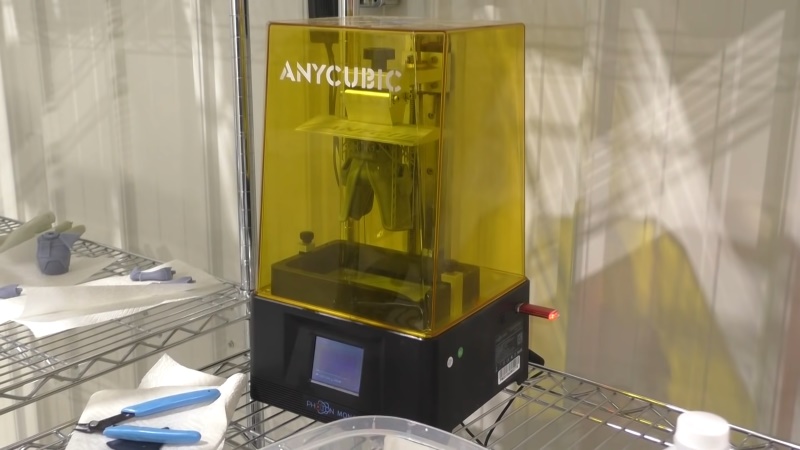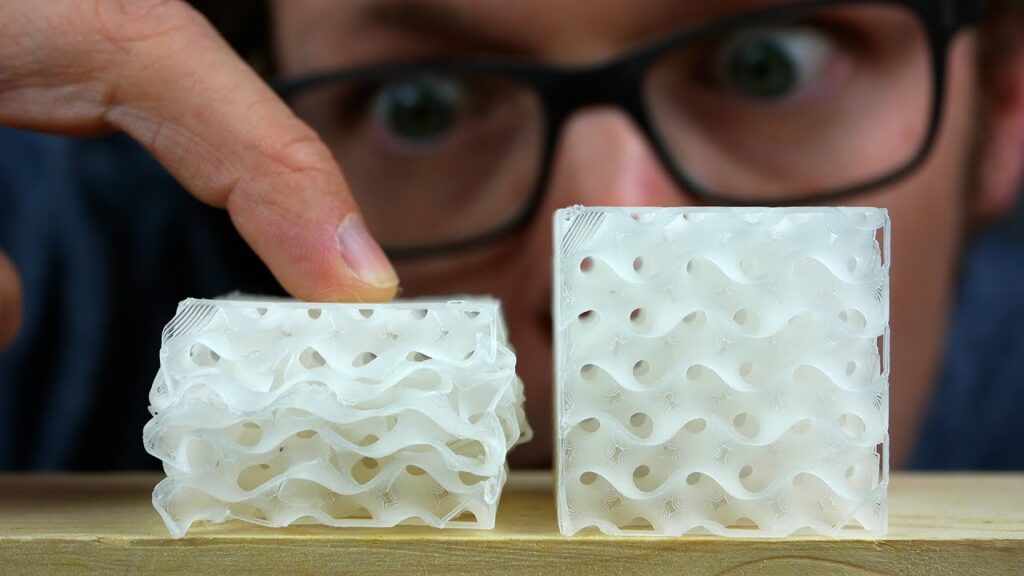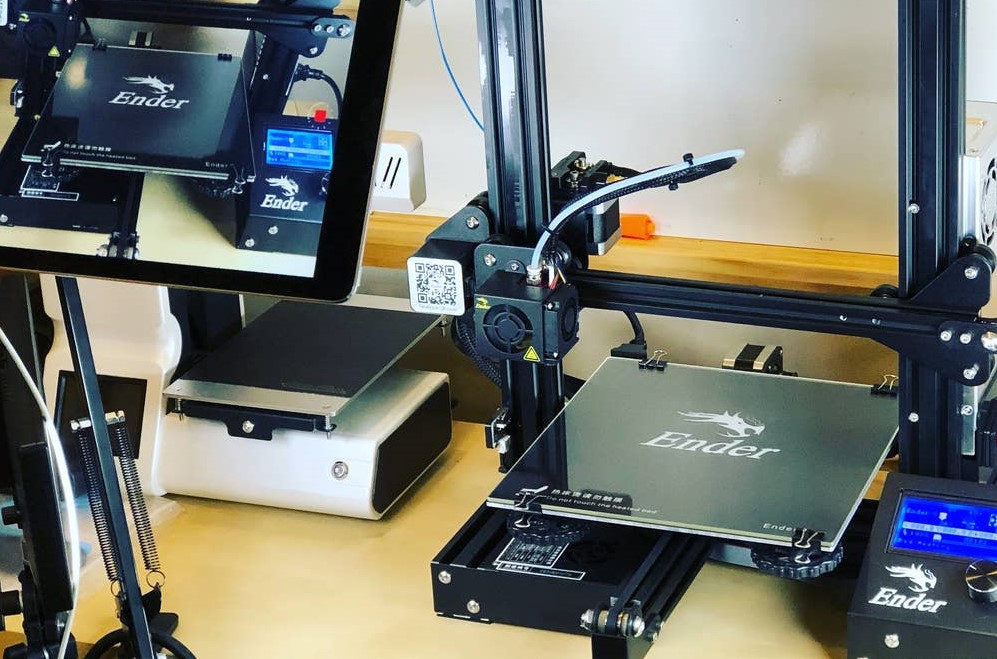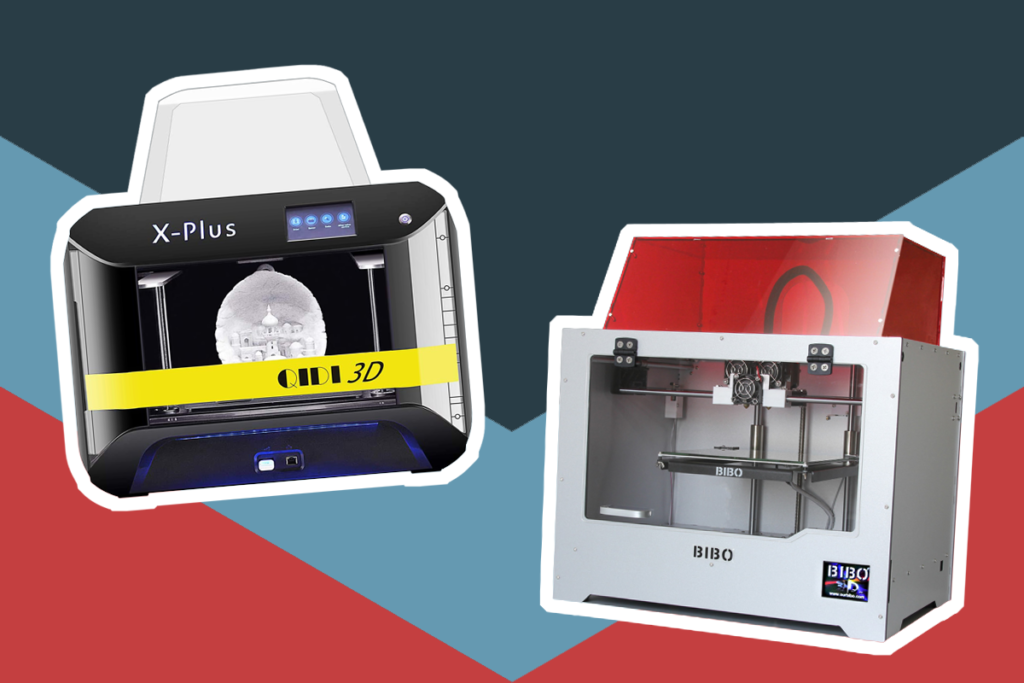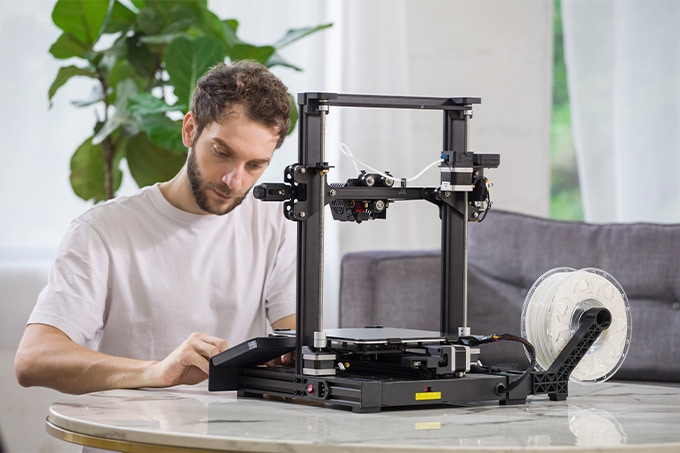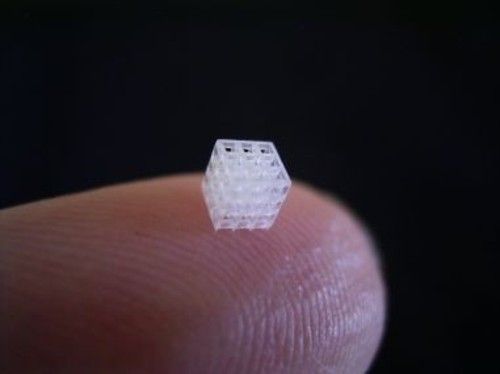

It’s never too late to get into 3D printing! And now is a great time since the market has been growing and shifting for the past few years coming up with amazing options for every budget. If you’re looking for the best 3D printer under $500, you’re in luck since it’s a golden middle when it comes to technology, design and quality of prints. You can find both beginner-friendly and advanced user-oriented machines in this price range.
To make your search easier, we’ve come up with a selection of the best 3D printers that proved themselves worthy to many creators, hobbyists and designers. Our buying guide will also introduce you to the most important features to know about and consider, such as printing technology, speed, volume and compatible materials.
More features: auto-leveling, dual cooling fans, double-gear extrusion system, SD card, large-size touch screen
ANYCUBIC Vyper comes from a popular brand loved by both beginners and advanced users. It has a large print volume and platform, especially for this price range, and allows you to create medium-sized projects without any trouble. Easy to assemble, it’s simple and intuitive on every step of the printing process, beginning with 4.3 inches LCD screen and concluding with effortless model removal. If you’re looking for a printer to set up at home, consider Vyper for its quiet operation, which makes it possible to create at any time without disturbing anyone. It’s also wear-resistant, which is perfect for those who wish to share their printer with others, family members or coworkers. And don’t forget that FDM technology makes it possible to print with a great choice of materials, like PLA, TPU, ABS, PETG and even wood.
Overall, the Anycubic Vyper is an excellent 3D printer that offers great features and value for the price. If you’re looking for a quality printer that won’t break the bank, this is the perfect option for you.
As stated previously, the Anycubic Viper is compatible with various materials. The Anycubic Viper is superior to other models, including the Creality3D Upgraded Ender-3 V2 3D Printer, our pick for the Most Reliable model. It is superior because of its auto-leveling feature. The intelligent leveling system will adjust an unleveled hotbed if you are new to 3D printing or do not want to waste materials. An unleveled hotbed will cause the nozzle to be too close to one area and too far from another. Your 3D print model will no longer reflect the design, and you will have to start over.
More features: noise-reduced, wear-resistant
Creality 3D CR-10S 3D Printer has the largest building volume on our list, 300 x 300 x 400 mm, to be exact. It boasts a powerful Z-axis motor and a 100 mm/s maximum speed, which is very decent at this price range. As with any other FDM printer, it supports a variety of materials, including copper and carbon fibre. It’s compatible with Windows, mac and Linux and supports all of the popular file formats. If you love Cura software, you won’t be disappointed since CR-10S works great with it, as well as with Simplify and Repertier-host. The feature we especially love is resume printing since no one is immune to power shortages or other sorts of interruptions.
One of the biggest advantages of the Creality3D CR-10S is its price. At under $500, it’s one of the most affordable 3D printers on the market. It’s also a very reliable printer, which is compatible with a range of materials.
The Creality3D CR-10S is more expensive than other models like the Anycubic Vyper, our Editor’s Choice, and the Photon Mono SE, the Best for Hobbyist. It still is an affordable 3D printer, landing on our list of 3D printers for under 500 dollars. While it is more expensive than other models on this list, it is much more reliable and durable. You will not run into the same manufacturer or operator issues. You can depend on the Creality3D CR-10S to print quality 3D images every single time.
More features: wear-resistant aluminum profile, Wi-Fi, SD card, easy-to-assemble
Geeetech A10 Pro 3D Printer Kit is an affordable yet versatile printer. We usually recommend going for a cheaper option if you’re a beginner since there’s more freedom for learning and the price for mistakes is not too high. It’s not to say that A10 Pro has nothing to offer for more experienced users. It has a simple, easy-to-understand design and is compatible with most operating systems while working with almost every software. It can be connected to your computer via both USB cable and WiFi, and therefore also works with EasyPrint 3D remote App. You can print models with smaller details thanks to the 0.1 mm accuracy and stable platform that allows the temperature to be distributed quickly and evenly. Geeetech won’t disappoint you with its filament detector technology, which alerts you about material outages or fractures.
The Geeetech A10 Pro 3D Printer Kit is the most affordable 3D printer on this list. You can buy a quality 3D printer without spending nearly as much money as the Creality3D CR-10S model, which stands for the Premium Pick. The nozzle diameter is the same as the Creality3D CR-10S model. However, the print bed is not heated like the Anycubic Vyper, which may negatively affect the 3D model print.
More features: carborundum glass platform, easy-to-assemble, silent operation (under 50dB), SD card
Creality Ender 3 V2 3D Printer is another FDM option on our list. Compatible with easy-to-use materials, it has a decent printing speed and a versatile 0.4 mm nozzle. This all is complimented with a thought-through compact design, perfect for a smaller home or office. Talking about communal paces, Creality states that this printer is ultra-silent, under 50 dB, to be precise. It has a carborundum platform and integrated-metal body that proved to be highly functional in previous models. Ender 3 V2 only takes 5 minutes to heat up and due to its platform material is able to hold the temperature steadily through the whole printing process. In case you are a beginner and worry that you will outgrow your printer too quickly, consider that this model can be easily upgraded with additional tools.
In comparison to similar models like the Anycubic Vyper, our Editor’s Choice, there is little to no difference between the color display size and printing speed. However, the Creality3D Upgraded Ender-3 V2 3D Printer is much more affordable. You will save money while achieving the same printing capacities and capabilities. Your SD software is compatible with your personal computer and more user-friendly for beginners than like models.
More features: SD card, thermal runaway protection, auto-leveling sensor
One word to describe Sovol SV01 3D Printer is decent. You see, it has a nice price, it’s not too cheap, yet not expensive. It has all of the basic features for such a price: it works with PLA and other plastics and has a touchscreen and a flexible magnetic plate. These are not some exquisite features you can’t find somewhere else, but in the case of Sovol, it’s just done very well. Its motherboard is silent, the touchscreen is intuitive and bright, and the auto-levelling sensor responds with high precision – it all makes a printer that is known to be ideal for beginners.
If you are new to 3D printing, you will want a 3D printer with auto-leveling. If the 3D printer is a manual model like the Creality3D Upgraded Ender-3 V2 3D Printer, which is the Most Reliable model in our list, you will have to reconfigure the entire printer before each use. While the Sovol SV01 3D printer does not offer Wi-Fi connectivity, it is a better printer for beginners because of its durable construction and auto-leveling feature.
More features: 3.5 inch touch screen, matrix parallel light, APP remote control, UV cooling system, comes with gloves, scraper, tool set, and USB drive
Finally, a resin printer on our list, ANYCUBIC Photon Mono SE. The problem with such printers is that they offer only one material to work with, and one may say it’s not a lot. They also cost expensive while at that. But you shouldn’t abandon the idea of getting it right away, because it can easily compensate for its disadvantages. Resin is actually a great material to work with and is popular among jewellery makers and other creators who need a lot of precision in their work, no matter how small the objects are. Photon Mono SE is perfect for creating smooth surfaces and lattice structures. It has a decent printing speed and a matrix parallel light source that guarantees more even heat dissipation. Meanwhile, the UV cooling system helps with cooling the device down to prolong its life.
The Photon Mono SE is the smallest 3D printer on the list and one of the most affordable printers. It is slightly noisier than the Creality3D CR-10S, the Premium Pick, and the FLSUN(Q5) QQ Mini Delta 3D Printer, the Beginner’s Choice. However, it is much more affordable. It is the perfect 3D printer for the hobbyist looking for a user-friendly 3D printer.
More features: silent operating (less than 50dB), touchscreen, Wi-Fi connection
FLSun(Q5) QQ Mini is a compact and easy-to-use FDM printer. Its building volume, which is 200 x 200 x 200 mm, is the smallest one among FDM printers on our list, but not drastically so. What it lacks in size, it compensates with its 80-150 mm/s speed and a great variety of materials it’s compatible with, HIPS among them. Another wonderful feature is its automatic bed levelling with a sensor, which makes it possible to minimize warping and provide stronger adhesion. All in all, its temperature distribution is very smart, cooling down very fast after completion, allowing it to quickly remove a new model.
The FLSUN(Q5) QQ Mini Delta 3D Printer operates silently. If you are worried about noise, you should consider this printer over like models such as the Anycubic Viper, the Editor’s Choice, or the Photon Mono SE, the Best for Hobbyist. You can also build larger projects than with the Premium Pick, the Creality3D CR-10S printer due to its large build plate.
Getting yourself a new 3D printer may seem to be an overwhelming task, considering how large the market has grown in recent years. Deciding on your budget and price limit first is always a great idea. Best printers under $500 usually have many amazing characteristics that allow any user, beginner or advanced, to get a great result in their creative endeavours. We chose the most well-reviewed products from this price range, and below, you can find an in-detail guide about the features we evaluated.
$500 is a great price range to choose from because such products usually have very useful qualities for experienced users and businesses but are still beginner-friendly and easy to set up. To make the choosing process easier for you, we’ve put together a list of basic features every printer has and explained how they influence their work.

Printing technology, as it’s easy to guess, is a way printers works. It determines which materials you can use, how fast they can print, and how high the quality of your product can be. While 3D printing is a revolutionary field where new technologies keep appearing, especially in commercial and industrial sectors, there are two most popular and readily available for a common user: FDM (fused deposition modelling) and SLA (stereolithography).
FDM machines are incredibly popular and usually end up being everyone’s first 3D printer. The technology behind them is very basic: thermoplastic heats up and gets distributed through the nozzle in layers from the bottom up, creating your desired shape. There are many types of plastic that can be used with it, most very inexpensive, which explains the popularity behind these machines. They might not be as precise as the ones needed in fields that call for very accurate measurements, but they are used widely by designers and engineers when they need fast and cheap results. FLSun(Q5) QQ Mini is a great example since it supports several types of materials, has decent printing speed and takes very little space, perfect for smaller projects or trying your hand at printing without setting up a studio.
SLA machines are the ones that print with resin. It’s a great material to use when you need smooth and highly accurate results. Such printers use a light source, a laser or a projector to create hard plastic from liquid resin. Perfect for smaller details, it’s a wonderful option for users who want to level up their projects or businesses which sell detailed fan art. You can read our article about the best large resin 3D printers, which are a perfect solution for those who want to create big designs. SLA 3D printers, like ANYCUBIC Photon Mono SE, usually are more expensive and advanced, but with many tutorials available, you can easily learn how to use them and reap all of the benefits they offer.

SLA 3D printers can work only with resin. It’s a solid or viscous substance that comes from plants or can be of synthetic origin. You probably have seen it on Christmas trees before or even touched a sticky liquid substance on the core of many other plants. We’ve already described some of resin printers’ benefits, such as accuracy and high precision. Though it is more expensive, the results are really worth it.
FDM printers use different kinds of plastic. The most popular ones are PLA, ABS and nylon. ABS is very common, probably because it’s rather cheap due to the low production cost. Most likely, you have many objects around your house made of it. Easily molded, it’s a great solution for prototypes, but don’t think of it as something not worthy of your attention. Even Lego bricks rely on it. However, its ease of use has a downside because it can’t withstand high temperatures. So it’s better for it to avoid the sun, if melting your project isn’t your initial plan, and fire, since it’s hazardous when burned.
PLA, or polylactic acid, is a thermoplastic polyester that is usually produced with the help of renewable resources. It has the highest consumption volume compared to any other plastic. PLA can be mixed with some metals, woods and carbon fibre, which makes it incredibly versatile and allows many unique designs to be created with it. Just look at the best rainbow filaments. If disposed of correctly, it can be considered to be on an environmentally-friendly spectrum, though it’s still plastic, you know. Compared to ABS, it has much wider use due to it being food-safe. The downsides are the same, and it is not as heat resistant or strong. It may not be a problem if you don’t plan to expose it to the sun or if you actually look for a material with such qualities.
Last but not least is nylon, which comes from a family of synthetic polymers and is usually made from petroleum. It has a higher impact resistance than other options in this price range. While it can be flexible when thin and layered, it becomes particularly strong with decent abrasion resistance. If you’re sensitive to strong smells, choose nylon because it creates no unpleasant odours while melting. The downside is that it needs to be properly dried not to cause any defects, and you need to avoid humid and moist environments because it tends to absorb moisture all too well.
Most 3D printers are designed to cater to as wide of a client base as possible, so finding a machine that will connect to your computer shouldn’t be a problem. It does so with WiFi or a simple USB cable, requiring quite basic operating systems such as Windows 7, like ANYCUBIC Vyper, or higher, while some models work with Linux.
Also, it’s worth noting that many printers come with their own software and remote control apps, like Anycubic Photon Mono SE and other machines from this brand are accompanied by ANYCUBIC Photon workshop. If you wish to use a particular software, it’s always better to check with the manufacturer to be sure it works with their products. The same goes for file formats.
Printing speed, as one can guess, is all about how fast a machine can print. All of the models from our list have speeds of around 100-200 millimetres per second. One printer can have slightly different speeds depending on the material, project difficulty or how long and frequently you use it. The fastest one on our list is Sovol SV01 3D Printer with 80-180 mm/s, while ANYCUBIC Photon Mono SE is limited to 80 mm/s maximum due to the resin printing technology it uses. The fastest 3D printer can work around 1000 mm/s, but this applies to a high-end niche of the market, where one looks for semi-professional equipment and luxury brands.
Measured in millimetres, build volume is correlated with the size of an object possible to print with a particular machine. Products on our list all have volumes between 200 and 300 mm, with Creality CR-10S having an impressive 400 mm, which allows the creation of small to medium objects. There are 3D printers with larger volumes and plate sizes, but they are themselves bigger and need much more room. Price usually increases as well, so the bigger your project, the more money you need to spend on a printer.
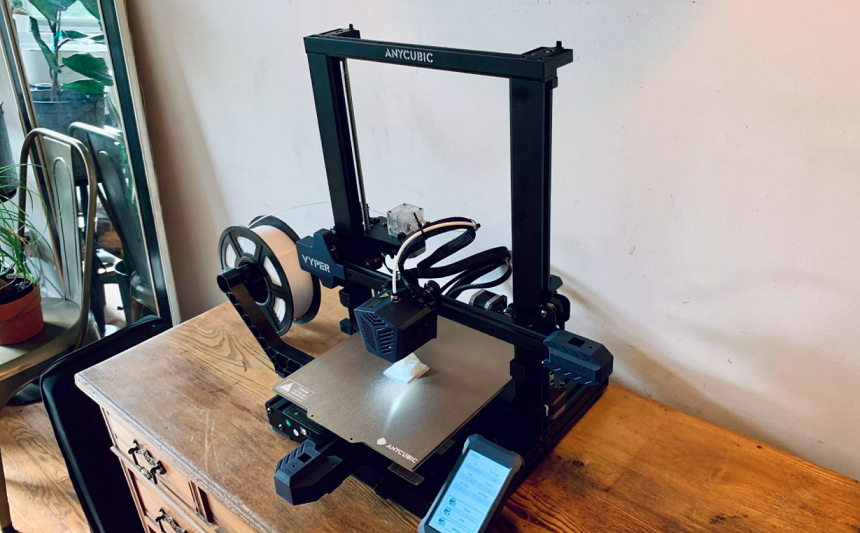
Printers come in many sizes, beginning with small ones, sometimes designed for kids, to very big, almost monstrous industrial machines. Products on our list are similar not only in their price but also in size and weight since such features are sometimes correlated. The $500 price range offers small and medium-sized printers for home or office use, so they don’t take up too much space and aren’t too heavy. If you have a particular place in mind where you want your printing station, it’s better to be more precise and have all of the measurements before you buy something.
Our forever advice is to always look for a product that has a warranty. All of the printers on our list offer one year, which is typical for this price range and should be enough to understand if there are any faults. If you only begin your printing journey and yet to know all of the smaller details about how such a machine should work, it’s always a good idea to contact customer support when in doubt and not shy away from returning or exchanging a product that doesn’t work. We know it sounds obvious, but don’t we all forget about it?
We’ve done our best to put this guide together and to present you with the best 3D printers under $500 the market can offer. By now, you know how important is the technology behind each machine and what to expect from different materials. While price range usually implies that products are somewhat similar to each other, we were able to rate them, depending on how efficient and easy to use they are, as well as choose the top three.
We adore ANYCUBIC Vyper, our Editor’s Choice, for its smart intuitive design, decent speed and great choice of materials to use. Creality CR-10S, our Premium Pick choice, is wear-resistant and operates very quietly, which makes it perfect for home use. And if you are looking for a perfect marriage of price and function, the Best Value Geeetech A10 Pro 3D Printer Kit is beginner friendly yet comes with advanced features.
